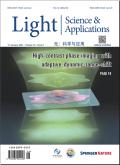Suppressed concentration quenching and tunable photoluminescence in Eu2+-activated Rb3Y(PO4)2 phosphors for full-spectrum lighting.
IF 20.6
Q1 OPTICS
引用次数: 0
Abstract
Highly efficient inorganic phosphors are desirable for lighting-emitting diode light sources, and increasing the doping concentration of activators is a common approach for enhancing the photoluminescence quantum yield (PLQY). However, the constraint of concentration quenching poses a great challenge for improving the PLQY. Herein, we propose a fundamental design principle by separating activators and prolonging their distance in Eu2+-activated Rb3Y(PO4)2 phosphors to inhibit concentration quenching, in which different quenching rates are controlled by the Eu distribution at various crystallographic sites. The blue-violet-emitting Rb3Y(PO4)2:xEu (x = 0.1%-15%) phosphors, with the occupation of Rb1, Rb2 and Y sites by Eu2+, exhibit rapid luminescence quenching with optimum external PLQY of 10% due to multi-channel energy migration. Interestingly, as the Eu concentration increases above 20%, Eu2+ prefer to occupy the Rb1 and Y sites with separated polyhedra and large interionic distances, resulting in green emission with suppressed concentration quenching, achieving an improved external PLQY of 41%. Our study provides a unique design perspective for elevating the efficiency of Eu2+-activated phosphors toward high-performance inorganic luminescent materials for full-spectrum lighting.用于全光谱照明的 Eu2+ 激活型 Rb3Y(PO4)2 荧光粉中的抑制浓度淬灭和可调光致发光。
高效无机荧光粉是发光二极管光源的理想选择,而提高活化剂的掺杂浓度是提高光致发光量子产率(PLQY)的常用方法。然而,浓度淬灭的限制给提高光致发光量子产率带来了巨大挑战。在此,我们提出了一种基本设计原理,即在 Eu2+ 激活的 Rb3Y(PO4)2 磷光体中分离激活剂并延长其距离以抑制浓度淬灭,其中不同的淬灭速率受不同晶体学位点的 Eu 分布控制。蓝紫色发光的 Rb3Y(PO4)2:xEu (x = 0.1%-15%) 磷光体的 Rb1、Rb2 和 Y 位点被 Eu2+ 占据,由于多通道能量迁移,这些磷光体表现出快速的发光淬灭,最佳外部 PLQY 为 10%。有趣的是,当 Eu 浓度增加到 20% 以上时,Eu2+ 更倾向于占据具有分离多面体和大离子间距的 Rb1 和 Y 位点,从而在抑制浓度淬灭的同时发出绿色荧光,外部 PLQY 提高到 41%。我们的研究为提高 Eu2+ 激活荧光粉的效率提供了一个独特的设计视角,使其成为用于全光谱照明的高性能无机发光材料。
本文章由计算机程序翻译,如有差异,请以英文原文为准。
求助全文
约1分钟内获得全文
求助全文
来源期刊

Light-Science & Applications
数理科学, 物理学I, 光学, 凝聚态物性 II :电子结构、电学、磁学和光学性质, 无机非金属材料, 无机非金属类光电信息与功能材料, 工程与材料, 信息科学, 光学和光电子学, 光学和光电子材料, 非线性光学与量子光学
自引率
0.00%
发文量
803
审稿时长
2.1 months
 求助内容:
求助内容: 应助结果提醒方式:
应助结果提醒方式:


